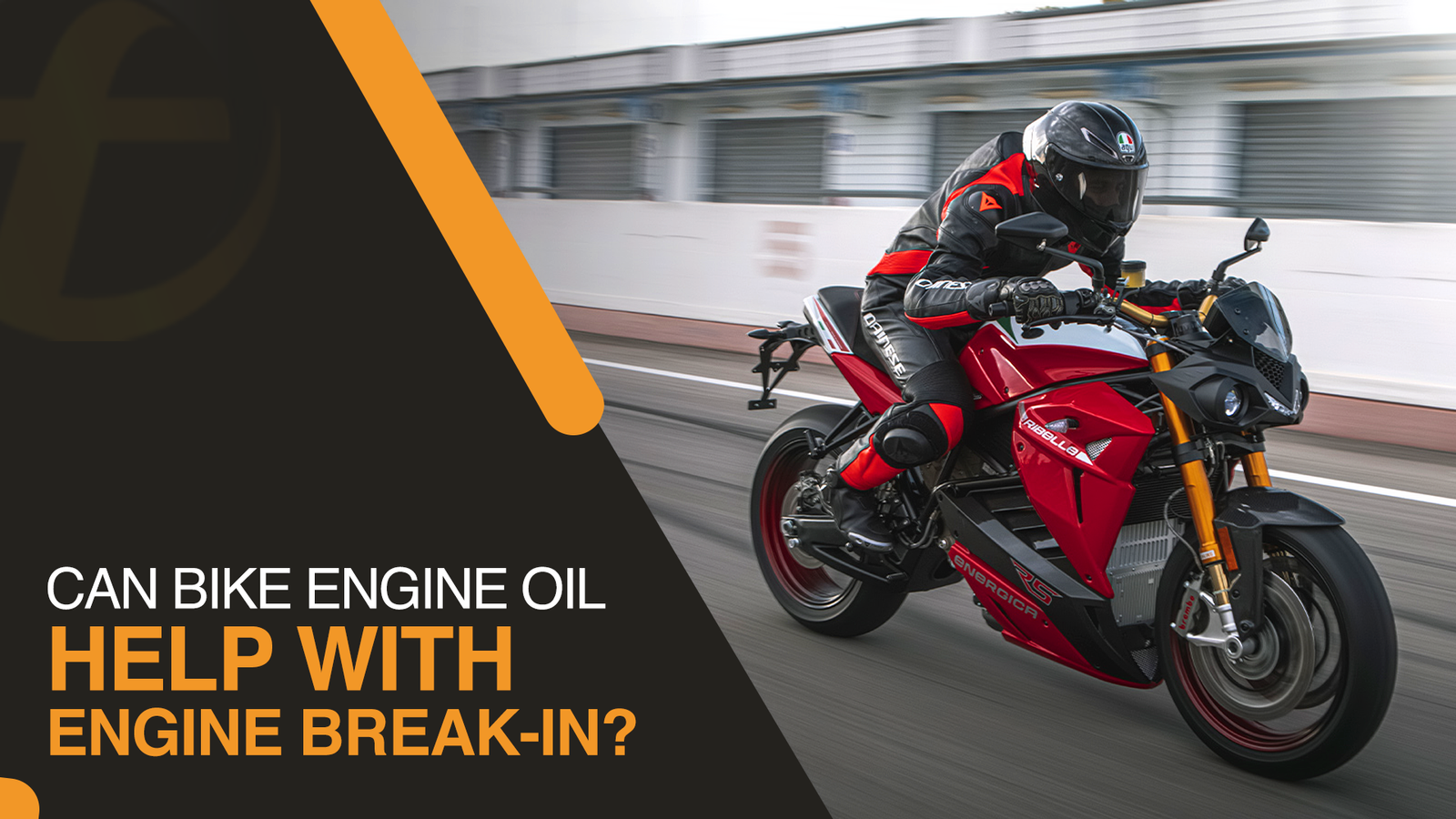
When you get a brand-new motorcycle, there’s something important you need to do before riding it fast: let the engine break in. It enables the various components of the engine to find their rightful place and function harmoniously, enhancing the bike’s performance and the engine’s durability.
Some of the questions commonly posed by riders include: “Can the motorcycle engine oil assist in the brake-in process of the engine?” The answer is yes! This process involves making the right decision and identifying the right oil to help the bike’s engine deliver better results in the future.
When considering the topic of this article, it is imperative to explain what engine break-in is, its importance, and the role that motorcycle engine oil can play.
What is an Engine Break-In?
New motorcycles also have an issue of the engine being ‘broken in,’ meaning the engine will still be learning to run when you first get on it to ride. This includes the pistons, cylinder walls and the piston rings used to make the engine.
These parts require time to wear each other and find the perfect match. This is what is referred to as the engine break-in process. When the motorcycle is running during the initial hundreds of miles, the rough edges of the respective engine parts rub against each other and form very narrow tolerances.
These seals assist the engine in combusting fuel effectively and, in so doing, consume a lesser amount of oil. If you do not cool it sharply, problems such as increased oil consumption and power loss may occur.
Why Is Engine Break-In Important for Motorcycles?
Motorcycles are designed with very narrow components and clearances. For instance, some pistons slide up and down inside cylinders, and the components must be one. During the break-in phase, these components experience a little wear to move uniformly and efficiently.
If you do not allow the engine to break in, the piston rings may not be able to sit against the cylinder walls as they should, leading to high friction and wear later on. However, if you follow the break-in steps, you can expect:
- Better performance
- Less oil usage
- Longer engine life
- Improved fuel efficiency
How Motorcycle Engine Oil Helps with Engine Break-In?
Choosing the right motorcycle engine oil is very crucial when it comes to break-ins. The oil helps the engine in several ways:
Lubrication
This reduces the friction experienced by moving parts such as the pistons and the cylinders. However, during a break-in, you require a certain level of friction so that the various components of the bike work correctly. The oil should balance this.
Cooling
When it is in the engine braking mode, it can overheat sometimes. It also helps cool the engine so it does not get too hot or reach critical operating temperatures.
Cleaning
When the parts are used over and over again, they result in abrasion and leave tiny metal particles behind. These pieces are trapped by the oil and taken to the oil filter to keep the engine clean.
Selection of the Right Oil for Engine Break-In
In sealing an engine process, there are certain types of oil sealing processes that need to be in the proper type. It is usually recommended that conventional or mineral oil should be used in most instances during the breaking-in period.
This type of oil is needed to create friction so that different parts of the engine fit together perfectly. Here’s a look at the different oils used during break-in:
Conventional Oil
This is usually the most advisable operation, especially when bedding in a new engine. It provides enough resistance that the piston rings can properly contact the cylinder liners. This type of break-in oil is common in many motorcycles where the factory fills the engine with such oil.
Synthetic Oil
This is because synthetic oil effectively reduces friction, making it an excellent choice for long-term engine use. However, synthetic oil can be problematic during the break-in process, as some friction is necessary for the engine components to wear in properly.
This indicates too little friction between the surfaces, and the parts will wear out incorrectly. For the best result, one is advised to switch to synthetic oil once the break-in period is complete.
Break-In Oil
Some companies make special break-in oils that are usually used during this process. These oils contain additives that help maximise engine performance during the initial stages while minimising deposits on the engine parts.
Viscosity
Viscosity is how thick or thin the oil is. When breaking in, there is the right viscosity you have to use on your bike. They range from 10w-40 to 20w-50, and you should use the viscosity the motorcycle manufacturer recommends. But always be sure to check with your owner’s manual.
How to Use Engine Oil for Break-In?
To help your engine break-in properly, follow these steps:
- Check the Owner’s Manual: Specifically, your motorcycle manual will likely indicate in the clearest manner possible what kind of oil you should use and how you should handle your motorcycle during the break-in period. It will advise the new rider to avoid high RPM or vigorous riding for the first few hundred miles.
- First Oil Change: This is the most crucial aspect because the first oil change is recommended after 600-1000 miles of proving trials. This is a crucial stage because, over the break-in period, the oil will have settled on small metal particles. Crucially, some people switch to synthetic oil after this first change for better long-term protection.
- Regular Oil Changes: After your motorcycle has broken in, it is advisable to adhere to the manufacturer’s recommended schedule for oil changes. This keeps the engine free from dirt and keeps it in good condition. You will get a schedule for this in your owner’s manual.
Mistakes to Avoid During Engine Break-In
- Riding Too Hard Too Soon: You should not take the bike to high RPMs or ride fast during the break-in period. The parts need to sit properly in the engine, which takes some time.
- Using Synthetic Oil During Break-In: Some riders believe that synthetic oil is the greatest from the beginning, but it can hinder the piston rings from exercising properly. Do not use full synthetic oil until the break-in period is complete.
- Ignoring Manufacturer Guidelines: These are not just the same motorcycles produced daily; every motorcycle is unique. Remember always to follow the manual in order not to cause harm to your bike.
Bottom Line
Warming up your motorcycle engine is very important to create smoother riding in your motorcycle for many years. Choosing the right oil when the engine is fresh can work wonders, unlike when using it after the engine has had a chance to wear in.
It is advisable to use conventional or special break-in oils since they enable friction of the engine parts that need to settle in. You can use synthetic oil after the break-in period to maximise long-term protection.
At Fubex Lubricants, we have all the products you need to maintain your motorcycle engine in the best condition. Whether you need a break-in or a high-quality synthetic oil, we are here to offer you all your services. Visit us today to get the right oil for your motorcycle and enjoy your ride with your engine protected!
FAQs
Q1: Can I use any oil for break-in?
Ans: When breaking in a new or rebuilt engine, using a special Break-In Engine Oil is a good idea. These oils are made from minerals and have extra ingredients to protect the engine.
Q2: How long does the break-in period last?
Ans: It depends on the vehicle. Most new bikes have no special break-in because they’re tested at the factory, and the oil is changed before they leave. However, the first service usually happens for motorcycles after riding about 600–1000 miles (or 1000–1500 km).
Q3: What are the signs of a successful break-in?
Ans: A successful engine break-in means your motorcycle is running well. You’ll notice that the engine feels smoother and doesn’t make strange noises or shake. It will also start using less oil than when you first started riding.


